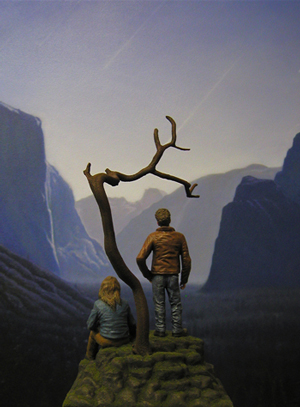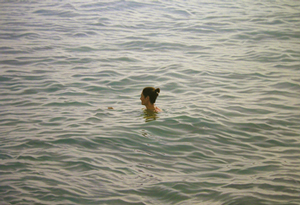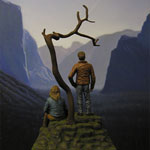ArtPace’s Hudson Showroom is featuring works by New York-based painter Peter Rostovsky. While questioning contemporary attitudes towards spiritualism, nature, and the sublime, Rostovsky references classical, modern, and post-modern painting through his trademark slick, photo-realistic style.

Peter Rostovsky ... Epiphany Model 4: The Meteor Shower, 2004...Oil on canvas wood, resin and acrylic ...
Facing the entrance to the gallery is the ominous, dominating canvas titled Eclipse. The image is a large, black sphere, around which flare wisps of tendril-like light, floating on a background of muted, muddy browns. It’s an immediate eye-catcher, like many of the works in the show, iconic and commanding, whose appeal is due much in part to our steadfast captivation with illusionist painting. However, any emotive reactions to the awesome nature of the celestial subject are downplayed by the flat, even-keeled application of the paint. The overall surface is so homogenously glossy as to suggest an enlarged photograph taken from an astronomy textbook.
In Epiphany Model 4: The Meteor Shower, two small figures sit on a tall pedestal positioned directly in front of an awe-inspiring mountain landscape. As meteors blaze through the night sky, the young male and female figures contemplate the scene with an air of coolness and remove. The piece suggests interesting questions with regard to how we mediate and romanticize our experience of nature (literally, in view of the history of landscape painting and concurrent with more updated mediums like the Travel Channel and National Geographic).
Rostovsky departs from the nature-as-subject theme in Rubik’s Cube, an homage to the 80’s puzzle known for challenging its players to re-order its color-coded grid by patiently working their way through potentially endless permutations. The cube sits alone in a non-descript void, grounded by a subtle reflection. This stark composition gives the viewer space to consider the formal qualities of the cube and its rows of contrasted squares of color in relation to other geometric-based abstraction. Like Eclipse, the surface of the painting is airbrush-smooth, suggesting a methodical process that purposely eliminates the artist’s touch. Yet the piece as a whole seems curiously concerned with representation for its own sake.
The final four works in the show are much less disparate in form and subject matter- each part of the same series derived from photographs that the artist took while visiting the beaches of Nice, France. Giving nondescript titles to the individual works (for example, Girl Swimming or Woman Swimming) adds to the sense of separation that the viewer feels when looking at the depictions of the lone, anonymous figures floating in the water. One larger work includes several figures that at first glance appear to have a group dynamic, yet closer inspection reveals them to be disengaged from one another. At a distance, the artist achieves impressive effects translating in paint the color and light qualities of the sun refracting off the ocean waves. Positioned as both visual tourist and voyeur, the viewer becomes an anchor to which the free-floating figures become empathetically tethered. Some of the magic gets lost though, getting up close and personal with the painting, as the surface breaks up into a series of mechanical, uninspired strokes.
Images courtesy the artist and ArtPace.
Michael Velliquette is an artist living in San Antonio, TX where he is Co-Director of the living / project space The Bower.




